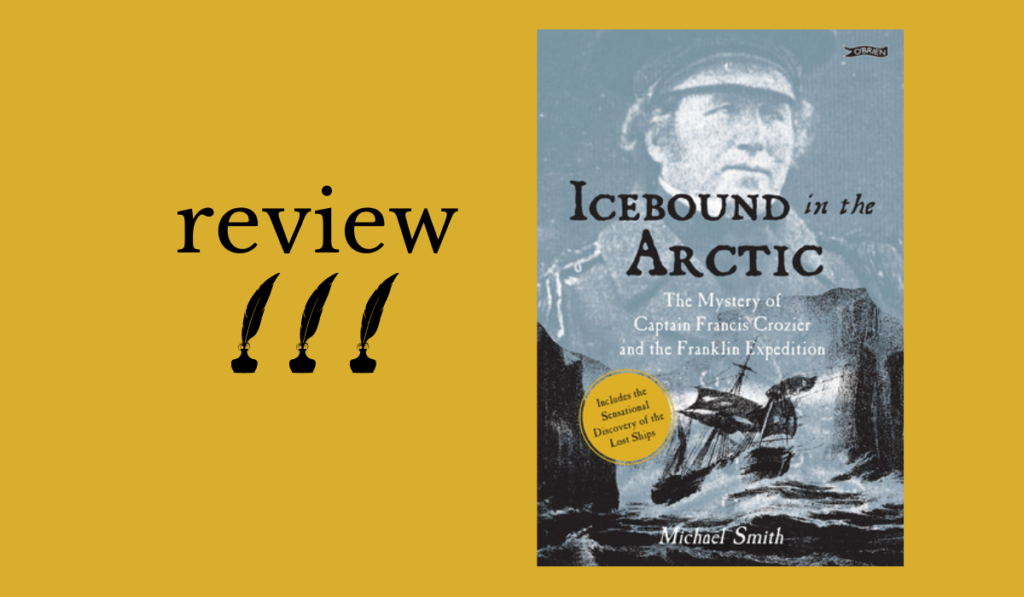
Icebound in the Arctic|Michael Smith|The O’Brien Press|ISBN: 9781788492324|€16.99
by Tony Canavan, Consulting Editor
I became acquainted with Francis Crozier when I was a child. In the 1960s, the main road south from Belfast went through Banbridge, his birthplace, and so every summer, going on holiday, we passed his statue in the town centre. I was fascinated not by the figure in uniform but by the four life-size polar bears surrounding him. When I was older I learned who Crozier was courtesy of a Radio Ulster broadcast for schools. I looked at the statue in a new light and have been interested in Irish Polar explorers ever since.
There is a photograph of the Banbridge memorial in Michael Smith’s book. Smith has established himself as a leading historian of Arctic and Antarctic exploration and has taken a particular interest in the Irishmen (they were all men in those days) who played a role in expeditions from Sir John Franklin’s in the nineteenth century to Ernest Shackleton’s in the twentieth. In doing so he rescued many of those men from obscurity—such as Tom Crean—who are now widely recognised as Irish heroes. Crozier was recently brought to public attention thanks to Dan Simmons‘s 2007 novel, The Terror, which was made into a TV series, shown on BBC2 and RTÉ2.
Crozier’s involvement with the Franklin expedition has overshadowed the rest of this life and it is to Smith’s credit that he gives us an account of Crozier before then.
As his full name – Francis Rawdon Moira Crozier – reveals, he was born into a gentry family in Co. Down. The family had shifted from dependence on land to success in the professions which is why it is a mystery that, at thirteen years of age, Crozier joined the Royal Navy. He saw service in the Napoleonic Wars but peace left him a junior officer on half pay with no ship. He was not alone in this and the Admiralty was facing a problem of what to do with the world’s largest navy in peace time.
The answer came from John Barrow, second secretary of the Admiralty, in the form of Polar exploration. Barrow believed that exploring the Arctic and Antarctic would increase Britain’s prestige, add territories to its empire, and open a new trade route between the Atlantic and Pacific oceans through the fabled North West Passage. Crozier jumped at the chance to participate and in 1821 joined Edward Parry’s second expedition to find the North West Passage.
In the course of this and subsequent voyages, Crozier became an expert in mapping the Earth’s magnetic field and in astronomical observation. He also proved himself coolheaded and resourceful in times of crisis. Unlike most British officers, he interacted with the Inuit people, learning their language, and how to travel across snow. In the following decades, he took part in many expeditions to the Arctic regions and in 1839 was the second in command of John Ross’s expedition to Antarctica, hoping to reach the South Pole. This was his introduction to Erebus and Terror, the two ships that Franklin would take on his final, fateful voyage. Ross’s expedition went further south than ever before with Crozier in command of the Terror.
However, this book is not just an account of Polar explorations. Smith also tries to understand the personality of Crozier. This is difficult as he never wrote a memoir and sources are scarce. Nevertheless, Smith paints a picture of a modest man, loved and admired by those who knew him. His lack of naval connections or patronage, as well as his reluctance to promote himself, meant that Crozier did not become a lieutenant until 1826. Another key to Crozier’s character was his unrequited love for Sara Cracroft, Franklin’s niece. His devotion to her was not returned and she refused his marriage proposal more than once. Smith believes that it was in hopes of impressing Sara that Crozier embarked on the final mission.
In describing British attempts at Polar exploration in this era, Smith says the template was set for heroic failure that reached its apogee in Scott’s doomed trek to the South Pole. The British refused to learn from the indigenous people and did things their own way. Part of this was the refusal to use dogs and to pull sleds themselves, a slow, fatiguing process. Lack of preparation was evident in other ways, such as inadequate clothing and reliance on processed food, rather than hunting local game.
Smith gives a vivid description of Ross’s final expedition into the Antarctic Circle with Crozier as his second in command. This lasted four years and saw the men involved enduring terrific hardships.
It left both Ross and Crozier broken men, in need of long rest and recovery. Smith cites this as one reason why Crozier should not have joined Franklin’s expedition in 1845.
Understandably, much of this book is devoted to this ill-fated attempt at the North West Passage. Consisting of Erebus and Terror (again under Crozier’s command) with 129 men, it was the largest, best equipped of any Polar expedition. Smith believes that it was doomed from the start. It embodied all the faults of the British approach to exploration and was too large to sustain a long stay in the Arctic region. On top of this, most of the crew had little or no experience on the ice, and Franklin was the wrong man to command it. He was not the first or even second choice, did not have as much experience as Crozier, and was too old. Smith thinks that Crozier should have been in command.
The outline of what happened is known and Smith does a great job of piecing together the evidence into a compelling narrative. He presents the various theories about Crozier’s death, even that he may have survived for years among the Inuit. The story of the aftermath is also compelling as numerous expeditions set out to rescue Franklin and his crew. For decades people gathered what relics were left and sought information from the Inuit.
The truth may never be known but hopes were given a boost with the recent discovery of the wrecks of Erebus and Terror. The painstaking process of analysing them has begun but it will be years before definitive conclusions can be drawn.












